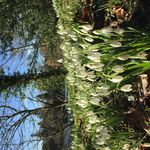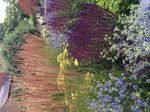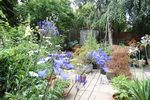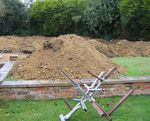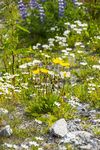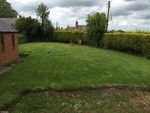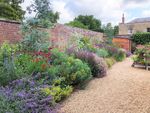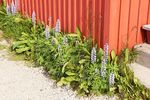INSIDE THIS - The Bourtons
←
→
Page content transcription
If your browser does not render page correctly, please read the page content below
Bourtons
Gardening
Club
NEWSLETTER
INSIDE
THIS
ISSUE
Snowdrops at
Wroxton Abbey, February
2019 Photo: A. Brooks
Sneak Peek; Buying Plants
Online by Julie Tomlin;
Virtual Online Garden
Tours; My Favourite… by
David Williams; The
Daisy; Photography
Advice by Barry Taylor
and Consider the Moon by
Michele Tyler.
WELCOME TO 2021’S FIRST NEWSLETTER
February February is a (some would say, ‘blessedly’) short month. The stars of
the garden are the snowdrops which, sure as eggs is eggs, are making
2021 their way up, regardless of the difficulties we are currently facing; it is
#3 month for enjoying the little things and looking forward to a kind and
gentle spring ~ Ann
~ ideas ~ news ~ advice ~ links ~ information ~
1Sneak Peek
Elaine and Barry
Taylor’s garden
in Banbury.
“We have 12
containers in our
back garden just
for Agapanthus,
and then a
further 73
containers
dotted around,
plus window
boxes and a hay
rack. Our
favourite place
to buy new pots
is Whichford
Pottery”.
[Photo: E. Taylor]
~ a message from Cropredy ~
I recently came across a little book of poems which belonged to my mother, writes Eraine.
FEBRUARY
The second month is dull and wet
We want to stay indoors and yet
Outside beneath the cold grey skies
The first lambs make their bleating cries.
It really is a joy to see
Them skip about so happily;
Then snowdrop pure and crocus gay
Tell us that Spring is on the way.
We have some snowdrops and hellebores in flower, a welcome sight after our snow.
Do hope everyone is well, please pass on our kind regards. Keep safe and well.
BUYING
Kind regards, ErainePLANTS
and AndriesONLIN
2BUYING PLANTS ONLINE
~ BY JULIE TOMLIN
“
In 2007 we found ourselves with a back garden that was devoid of plants - the result of installing
ground energy.
The need for deep trenches for the ground loop in a garden that was relatively compact meant
that we reduced our back garden to something more reminiscent of the battlefields of
Normandy... Why do we have torrential rainfall when trenches have to be dug??
Afterwards only rough grass colonised the slowly settling ground, and plants had to wait. And
wait. It took 10 years for the ground to finally settle...
3A garden slightly small for ground energy was actually rather large when it came to buying
plants. My long-planned plant list - with relatively large numbers of an edited list of varieties -
was going to be prohibitively expensive to buy. So, armed with my trusty RHS Plant finder, and
Google, I started searching.
Then (and even more so now in lockdown) plants from some of the major sources both online
and in garden centres, were expensive.
So how can we buy good quality plants we like, without spending a fortune?
I find that the first places to try are the specialists. A number of nurseries specialise in a few
genus and their stock is, in my experience, great quality, home grown and much cheaper than that
of the plant consolidators and garden centres. Some offer cheap or even free postage. Best of all,
many are run by those completely devoted to their product and very generous with their advice. I
love a character and thankfully, the gardening world is full of them.
Some of you may remember Gerald Sinclair at the Nursery Further Afield at Mixbury - he adored
Hemerocallis and visiting his nursery at flowering time is an experience I have never
forgotten. The daylily beds were spectacular! His enthusiasm was infectious. I was a relative
novice and he was thrilled to share his knowledge. I bought plants at £3.50 each and came away
with knowledge that was priceless. Since then, I have loved a specialist nursery and the people
that make them special.
The specialist nursery will have a true version of the variety you want to buy.
If they don’t have enough plants in a variety I need (or are out of stock) I ring them. The
stockholding online is often wrong (they are better growers than administrators) and more plants
are sometimes available. Or they will tell you when they will be available.
Recently I was trying to track down a pale blue Iris sibirica – ‘Perry’s Blue’. Google it and look
at the images - you will see a sea of different blue irises all purporting to be ‘Perry’s Blue’. I
rang Specialist Irises of Sissinghurst. They were out of stock of the “size they like to sell” - a
large division - but had 3 plants that were under size. I could have them for just the cost of the
postage... I had never bought from them before but will now.
4The iris was for a trial bed for a pictorial meadow planned for our front garden. Its rather
difficult location necessitated a trial - sheltered by the glorious oak tree opposite but also shaded
by it and the adjacent limes, when all are in leaf. But baked in full sun when the trees are
leafless. The soil has only previously grown rough grass, it is orange with unimproved clay and
has bedrock only a few inches below the surface. If I was a plant, I would refuse to grow
there...
However, the summer saw the trial bed full of flower - Leucanthemum apparently loves it as does
the “new” pale blue sage, Salvia nemerosa ‘Crystal Blue’. Less lofty than its cousin ‘Caradonna’
(which I also love) and a delicate clear pale blue, the salvias have thrived, flowering through to
November and are still throwing up the odd flower now (mid-winter). We wait to see how it
survives the winter but so far it is looking good. Its newness means that it has been offered at the
garden centres at ridiculously high prices. But the specialist salvia nursery that supplied my
plants (with free postage) made it affordable. Middleton Nurseries are up in Staffordshire, so I
figure that if salvias are hardy for them, they might be for me. (I buy from a nursery north of
here if what I am buying is borderline hardy.) Middleton also offer discounts to their loyal
customers... A great find.
If you are buying many types of plants these specialists might not work for you. I buy 5 or 7
plants of a variety, or even more, to plant bold swathes or give cohesive repetition across the
garden. However, if I am trialling varieties in smaller numbers, or infilling existing planting, Beth
Chatto, Claire Austin and Woottens are all worth a look. They specialise in a few plants, but
their overall ranges are huge, the wealth of information immense. Woottens also sells the
Plantsman’s Handbook - an amusing, opinionated, erudite publication, with detailed information
on a host of plants, written by Michael Loftus who returned “home” to Suffolk and started
Woottens nursery after a successful time in London making Neal’s Yard a household name. The
handbook is well worth a few hours of your life...
If buying for shade, Long Acre Plants is a great find. This Somerset nursery specialises in shade
loving plants and their website is informative. All the plants bought from here have thrived.
Our garden has lots of grasses - they provide height and structure in the absence of the large
shrubs and trees that would potentially damage our ground loop. When I started designing the
garden Piet Oudolf was a relatively new name in the UK and grasses were not readily available in
the garden centres. Neil Lucas at Knoll Gardens was the source of all information and offered
the best range of grasses and sedges. He still does. Yet his grasses (and perennials) are usually
better priced than those at the garden centre and his varieties are correctly named. I sometimes
disagree with his descriptions (his “gently creeping” Carex was more “intent on world
domination” even in my awful soil) but he remains the best grass specialist.
5Stipa pseudoichu with Echinacea ‘White Swan’
Be aware though that whilst many plants are successfully established from a 9cm pot, not all true
grasses are. Many grasses hate being divided and sulk for at least year afterwards. A small
division or a small plant may die so I try to buy true grasses in at least a 1 litre pot, to help them
establish and survive. I accept that they will sulk. But buying bigger plants means that postage
rates are an important consideration.
6We are lucky to have some good plant centres around us - Hillier, Farnborough, Barn Farm
Plants and the National Herb Centre offer a good range year-round and great service. It is
important to support our local businesses. But I couldn’t always find what I wanted, in quantity,
at a price I wanted to pay. If you want to plant asters in April for example you won’t find them
in a garden centre. Online plant buying has proved a good alternative and whilst I have had the
occasional bad experience, buying from online specialists has enabled me to find a wide range of
plants and given me access to a wealth of knowledge from some really committed
growers. There are some excellent small nurseries out there grateful for your business and
deserving of it. Perhaps worth giving them a try?
Sources:
Beth Chatto -https://www.bethchatto.co.uk/
Claire Austin Hardy Plants - https://claireaustin-hardyplants.co.uk/
Irises of Sissinghurst - https://irisofsissinghurst.com/
Knoll Gardens - https://www.knollgardens.co.uk/ Subscriber discounts
Long Acre Plants - https://www.plantsforshade.co.uk/
Middleton Nurseries - https://middletonnurseries.co.uk/ Free delivery over £35 at the moment
and returning customer discounts
Woottens of Wenhaston - https://www.woottensplants.com/
[Photos: J Tomlin]
Have you visited a garden you would like to
share with the BGC group? Please send text
and photos to annbrooks100@gmail.com
7“ What good is the warmth of summer, without the cold
of winter to give it sweetness”.
~ John Steinbeck
My favourite ......... by David Williams
1. Garden I have visited within 40 miles of Great Bourton: Kiftsgate. I loved the variety
of formality and wilderness.
2. Gardening TV programme: Gardeners’ World
3. Gardening radio programme: I sometimes listen to Gardeners’ Question Time.
4. Vegetable or fruit I grew in my garden: A thornless Blackberry, variety not known but
reliably has produced huge, sweet berries for some 12- 15 years.
5. Gardening task: Strangely, dead heading. It can be tedious, but its immediate tidying
effect is very satisfying.
6. Place to buy plants locally: Farnborough Nursery. They provide a wide range of
excellent quality plants and offer exceptionally good service.
7. Plant in my garden: A Pieris in a large barrel. It is always of interest; apart from its
elegant form, it produces red bracts, white flowers and red new growth throughout the
year.
8. Season of the gardening year: Late spring when, due to a neighbour’s overhanging
Leylandii, the heavily shaded acid bed produces delicate Erythronium (dog’s tooth violet)
and rare double Sanguinaria (bloodroot) flowers which herald the start of warmer weather.
9. Garden I have ever visited: The Lost Gardens of Heligan in Cornwall. I particularly like
the wilderness around the water features.
8VIRTUAL GARDEN TOURS ONLINE
In the depths of winter, especially this one, who could say no to a visit to a garden, with no issues
of social distancing or even an entrance fee?
Welcome to the world of online visual tours.
Here are some links to ones I think you might like, but there are thousands available if you want to
go exploring.
Firstly, here is a link to a website called “The Spaces” and its 9 garden tours to Versailles, Monet’s
garden in Giverny plus gardens in Italy, Brazil and the US.
Next up is Gardens Illustrated’s best 12 virtual garden tours.
The Royal Botanic Gardens in Kew has its own YouTube channel (you will need to have the
YouTube app on your device) which has plenty of tours of both Kew and Wakehurst, but also
Science Stories, How-to pieces and Plant profiles.
The magazine The English Garden also has its top picks of gardens, including West Dean and
Mapperton, two gardens I would love to visit.
If you can still fit more into your schedule, as you would expect Wisley and the other RHS gardens
have lots of tours here and the NGS has a wide range of virtual tours grouped under enticing titles
like Cotswold Gardens, Smaller and Suburban Gardens, and Designer’s Gardens.
One more interesting website I recently stumbled across is a series of drawings of root systems,
courtesy of Wageningen University in the Netherlands. I found them strangely diverting.
Alyssum montanum
9DiD YOU KNOW? The Daisy
The word daisy is a contraction of ‘day’s eye’ from the old English dæges eage, so called
because the petals of some of the species open at dawn and close at dusk. For the same
reason, in Medieval Latin, a common term for daisy was solis oculus, meaning ‘sun’s eye’ .
My favourite within the family is Erigeron karvinskianus, shown here on the steps of the
beautiful Chivel Farm garden we visited last year. It self-seeds around the garden, so once
you have it, it pops up here and there, adding cheer and happiness.
[Photo: A. Brooks]
10CONSIDER THE MOON
~ by Michele Tyler
“
As the planting season will soon be upon us, perhaps now, while we have some extra time
during this lockdown, it is a good moment to consider when to sow your seeds or plant up your
seedlings.
You will have heard the Old Wives’ tale about doing your planting at the time of the waxing
moon when the moon’s illumination is growing, but is there any down-to-earth evidence for
this? Science has now proven that the phases of the moon affect the earth’s magnetic field
which in turn give us the sea tides. But how does that affect our plants?
Research has found that the same pull of the moon affects all water - even the tiniest drop has
a micro-tide. Of course, a large proportion of plants is composed of water so it makes sense
that plants would have more energy to grow as the moon ‘grows’ in our sky. Our atmosphere is
also affected and so it is more likely to give us some soaking rain immediately after a full or
new moon - exactly what we want when our plants have just gone into the ground! The
additional light coming from a waxing to full moon also encourages leaf growth, while the
waning moon encourages root growth.
The moon is waxing when we can see any part of its right half lit up and it is waning when no
portion of the moon’s right half is visible, or we can see the left side lit. Dates for the new
moon this year are:
13 January, 11 February, 13 March, 12 April, 11 May, 10 June, 10 July, 8 August, 7
September, 6 October, 4 November and 4 December.
The moon is waxing for two weeks after these dates until the full moon so using this theory,
these are the best times to do your planting.
While looking for the new moon dates, I also found the information below in which might also
be of interest. The ‘super full moons’ occur when the moon is nearest in its orbit to the earth
so this must also help our plants to grow - lucky then that the two this year are in the spring!
11SPECIAL MOON EVENTS IN 2021
• Super Full Moon: 27th April
• Micro New Moon: 11 May
• Super Full Moon: 26 May
• Blue Moon: 22 Aug (third Full Moon in a season with four Full Moons)
• Super New Moon: 4 Nov
• Partial Lunar Eclipse visible in London on 19 Nov
• Micro Full Moon: 19 Nov
• Super New Moon: 4 Dec
• Micro Full Moon: 19 Dec
• No Black Moon in London in 2021 (third New Moon in a season with four New Moons)
And finally
Some advice on photography in the garden by Barry Taylor
I enjoy taking photographs of all gardens. All I do is see what I like, line the camera up and take the
shot. There are many gardens that I love, but one of the best is RHS Harlow Carr just outside
Harrogate; this shot of the tulips was taken there.
12If you are taking your camera on a garden visit, it can be useful to take the instruction manual! Also
pack a spare battery, and a polyethylene bag - not to put cuttings in, but to put one knee on for low
down shots. The first rule is getting up early, have breakfast and park up to be the first in. The
advantage of this is you don’t see other people for a while, then it’s only a few, and at about t10am
they all come in, some to have breakfast! They are the ones with the clean wellies! If people are in
the way, I wait until they have gone, or I come back later. A lot of professional photographs are
taken after the visitors have gone home or early before you get there: this is because the light is softer.
If you have a tripod that will help too.
Here are some pictures I took in Greenland:
1314
THANKS AGAIN TO ALL OUR CONTRIBUTORS. DON’T FORGET
THAT WE ARE HOPING TO VISIT ADMINGTON HALL (below) ON
JUNE 2ND.
15You can also read
